|
The 8th/9th Battalion, Royal Australian Regiment was formed on the 31st
October 1973 from the linking of the 8th Battalion, RAR and the 9th
Battalion, RAR as a result of the downsizing of the Army following the
Vietnam campaign.
 In
the 24-year history of the battalion, it trained for war in a period of
peace and regional stability. Whilst the battalion was never deployed on
operational service it played a key role to the nation and in particular
to the local community in the South East Queensland region. In particular
the battalion was tasked with the role of disaster relief and the
subsequent cleaning up of the substantial damage caused by the devastating
Brisbane Floods in 1974. In
the 24-year history of the battalion, it trained for war in a period of
peace and regional stability. Whilst the battalion was never deployed on
operational service it played a key role to the nation and in particular
to the local community in the South East Queensland region. In particular
the battalion was tasked with the role of disaster relief and the
subsequent cleaning up of the substantial damage caused by the devastating
Brisbane Floods in 1974.
The battalion survived a number of upheavals in its time, the first in
1980 with the introduction of the Operational Deployment Force (ODF),
where the battalion lost over 250 soldiers to bolster the ODF battalions
(1RAR and 2/4RAR).
During the 1980s the 6th Brigade, including the 8th/9th Battalion and the
6th Battalion, was tasked with the development of the Australian Army's
amphibious capability and to establish fighting procedures in Urban
Terrain.
In the early 1990's the battalion embarked on an ambitious endeavour to
recruit residents of South East Queensland to the battalion. This was
known as direct enlistment and these soldiers were to have served a
minimum of four years with the battalion at Enoggera before being
considered for posted to another battalion. Whilst this concept was highly
successful the subsequent transition to a Ready Reserve Battalion saw many
of these soldiers posted to the Operational Deployment Force in
Townsville.
In 1990 the battalion was involved in the Papua New Guinea Training
program whereby the battalion was responsible for assisting the New Guinea
Defence Forces train its soldiers. This role lasted until 1992 before the
battalion was re-designated in January 1992 to become a Ready Reserve
Battalion with an emphasis on Light Infantry.
The 'Ready Reserve' scheme consisted of soldiers undertaking a commitment
to the Army to serve as a "full-time" soldier for a period of
one year, followed by five years as a part-time soldier serving a minimum
of 100 days each year. In return the Army provided education and
employment assistance for each soldier after the completion of the
"full-time" year.
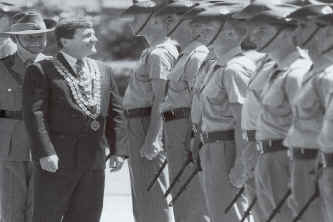
On Saturday the 10th October 1992 the battalion was granted the Right to
the Freedom of Entry to the City of Brisbane which confirmed the
battalions long association with the city and reflected the long term
respect and a mutual understanding between the community and the unit.
Lord Mayor
Soorley inspects the battalion
In 1996 as a consequence of the 6th Brigade's transition to a motorised
fighting formation the battalion was equipped with Stage 2 Bushranger
vehicles and commenced to train in its newly designated role of motorised
infantry. The battalion remained in existence until the 30th June 1997
when due to a major restructuring of the Army the 8th/9th Battalion was
removed from the 'ORBAT'.
On the 18th June 1997 a final tribute to the Regimental colours of both
battalion's occurred before they were laid up at the Infantry Corps museum
at the Infantry Centre, Singleton. A large contingent of current serving
members of the battalion together with many ex-serving members of the 8th
Battalion, 9th Battalion and the linked 8th/9th Battalion attended which
led to the subsequent forming of the association.
8/9 RAR Badge Distribution:
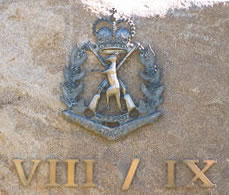 On
the removal of 8/9 RAR from the 'ORBAT' the distribution of battalion
property was a priority with battalion staff conducted an extensive stock
take of the battalions memorabilia and possessions and the property
was divided into three distinct collections reflective of its origin (ie
8RAR, 9RAR and 8/9RAR) and a small amount was returned to those people who
had donated it, on their request. On
the removal of 8/9 RAR from the 'ORBAT' the distribution of battalion
property was a priority with battalion staff conducted an extensive stock
take of the battalions memorabilia and possessions and the property
was divided into three distinct collections reflective of its origin (ie
8RAR, 9RAR and 8/9RAR) and a small amount was returned to those people who
had donated it, on their request.
The large brass "Skippy badges" that were prominently displayed
in the battalion area were distributed to a location or unit indicative of
its origin with the intention that these units would be the custodian
until such time as the badges were required again should the battalion be
reformed in the future.
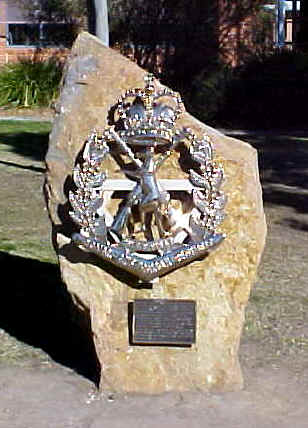 One
was placed in the custody of "Depot Company", School of Infantry
at Singleton (shown on right) whilst the other is held with the 4th
Battalion (CDO), RAR at Holsworthy. One
was placed in the custody of "Depot Company", School of Infantry
at Singleton (shown on right) whilst the other is held with the 4th
Battalion (CDO), RAR at Holsworthy.
The association would like to thank the former RSM of the Battalion WO1
Mark Levine for his input in regards to this information.
| It is
possible that there was a 3rd large badge from in front of BHQ that was donated to the RAR
Walk |
these details and some photos from the 8/9 RAR
Association web site
|

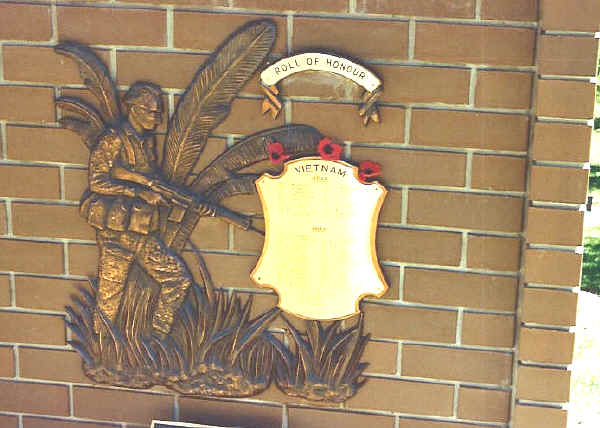
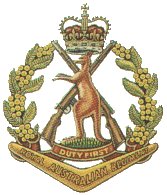
 In
the 24-year history of the battalion, it trained for war in a period of
peace and regional stability. Whilst the battalion was never deployed on
operational service it played a key role to the nation and in particular
to the local community in the South East Queensland region. In particular
the battalion was tasked with the role of disaster relief and the
subsequent cleaning up of the substantial damage caused by the devastating
Brisbane Floods in 1974.
In
the 24-year history of the battalion, it trained for war in a period of
peace and regional stability. Whilst the battalion was never deployed on
operational service it played a key role to the nation and in particular
to the local community in the South East Queensland region. In particular
the battalion was tasked with the role of disaster relief and the
subsequent cleaning up of the substantial damage caused by the devastating
Brisbane Floods in 1974.
 On
the removal of 8/9 RAR from the 'ORBAT' the distribution of battalion
property was a priority with battalion staff conducted an extensive stock
take of the battalions memorabilia and possessions and the property
was divided into three distinct collections reflective of its origin (ie
8RAR, 9RAR and 8/9RAR) and a small amount was returned to those people who
had donated it, on their request.
On
the removal of 8/9 RAR from the 'ORBAT' the distribution of battalion
property was a priority with battalion staff conducted an extensive stock
take of the battalions memorabilia and possessions and the property
was divided into three distinct collections reflective of its origin (ie
8RAR, 9RAR and 8/9RAR) and a small amount was returned to those people who
had donated it, on their request. One
was placed in the custody of "Depot Company", School of Infantry
at Singleton (shown on right) whilst the other is held with the 4th
Battalion (CDO), RAR at Holsworthy.
One
was placed in the custody of "Depot Company", School of Infantry
at Singleton (shown on right) whilst the other is held with the 4th
Battalion (CDO), RAR at Holsworthy.